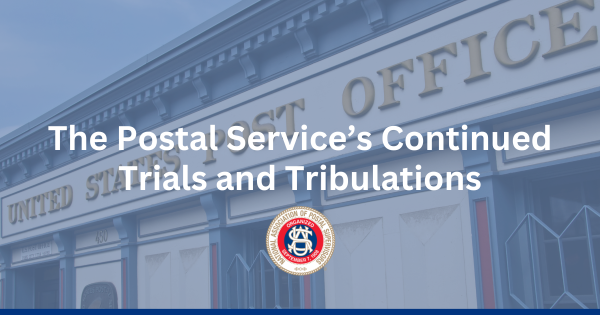The Postal Service's Continued Trials and Tribulations
The Postal Service’s Continued Trials and Tribulations
By Bob Levi
NAPS Director of Legislative & Political Affairs
The Postal Service recently reported its bottom line for FY25 that ended on Sept. 30; it’s not pretty. NAPS is not the only one taking note of the year-end, projected $7 billion loss. (The Board of Governors’ decision to defer a January 2026 postage rate adjustment will reduce expected second quarter FY26 revenue, further impacting the bottom line.)
There are several ravenous, private-sector interests who view these distressing numbers as an opportunity to feast on the 250-year-old national treasure. After all, the Postal Service still generates approximately $80 billion in revenue and touches virtually every American citizen and business daily. Kevin Kosar, my good friend and senior fellow at the American Enterprise Institute, in a recent article published by the institute, underscored this sobering postal narrative should an action plan not be implemented immediately. Kosar has vast experience in postal matters, including serving as the Congressional Research Service’s resident postal expert for a decade. NAPS members may be familiar with him as he has been a periodic guest on NAPS Chat and spoke at the 2024 NAPS Legislative Training Seminar. While I may disagree with him on several postal-related matters, I concur with him regarding the big picture—that is, plunging mail volume is having a devastating impact on the Postal Service’s capability to fulfill its universal service obligation.
Yes, the Postal Service must maintain a vast network of retail postal outlets that reach out to rural communities. Yes, the Postal Service is required to deliver letters and parcels at least six days a week. And yes, Postal Service-imposed postage must be affordable.
A dedicated career workforce of 506,110 (Sept. 19, 2025) is committed to satisfying the agency’s universal service obligation. Nevertheless, how can the Postal Service sustain its duty to “bind the nation together” with its current financial trajectory? The NAPS resident officers and I, as well as the entire NAPS legislative infrastructure and our congressional allies, are striving to answer this decisive question. Consistent with this effort, NAPS is working with the newly established, bipartisan Congressional Postal Service Caucus to accomplish the Herculean feat. (This complements our efforts with the established congressional committees that have jurisdiction over the Postal Service.) In late September, Executive Vice President Chuck Mulidore and I were privileged to be invited to and participate in the formal rollout of the Congressional Postal Service Caucus. The historic event took place under a sunny sky on the U.S. Capitol grounds. Caucus co-chairs Reps. Nikki Budz-inski (D-IL) and Jack Bergman (R-MI) convened the event and outlined the group’s mission and how it intends to influence congressional, postal and White House decisions over the future of the Postal Service. It should be noted that NAPS Michiana Area Vice President Kevin Trayer and Michigan Legislative Chair David Hommerson laid the foundation for Bergman’s leadership in the caucus.
They have worked with the representative and his staff for an extended time, familiarizing them with the challenges confronting the Postal Service and how service issues could be remedied. Budzinski is familiar with postal issues as a result of her previous representation of a labor union on the Federal-Postal Coalition, of which NAPS is a long-term member, and being a former, high-ranking staff member on the White House Office of Management and Budget.
Shortly after the caucus rollout, the USPS Office of Inspector General (IG) published a Sept. 22 audit report on postal retail accessibility and followed up with a Sept. 26 “white paper” on the evolution of the USPS post office network. Taken together, the IG raised concerns about retail access consistency and the future of post offices as America knows them. These reports should resonate with all frontline postal supervisors and managers, but specifically with postmasters and station managers. One of the points made in the white paper was the Postal Service retail network generally covers its costs. Retail units generated $9.3 billion in revenue, yet cost $6.3 billion to operate. However, the paper continued that, individually, more than half of the retail units failed to cover their costs. The paper also suggested that the USPS has not adapted its retail network to reflect population shifts. Moreover, the IG illustrated how foreign postal authorities maximize the use of their postal retail units by providing a more comprehensive menu of governmental goods and services. This type of analysis could be useful in expanding the array of postal products marketed and sold in postal retail units.
Along with the concern about sustaining universal service, the Oct. 1 partial federal government shutdown commanded congressional attention. Although the partial closure did not impact postal operations, it may impact several benefit programs postal employees and retirees use. For example, the government closure likely will slow the speed with which postal retirement applications are processed, impair the operation of the Postal Service Health Benefits open season and curtail the Office of Personnel Management’s staffing of retirement and postal health insurance helplines. On a final note, in early October, Postal Regulatory Commission (PRC) Chairman Michael Kubayanda announced his departure. He made clear his leaving was voluntary and he was considering the move for some time. The PRC gavel returns to Vice Chairman Robert Taub on an interim basis until either of three actions take place—President Trump designates Taub as chairman; designates another commissioner as chairman; or nominates and the Senate confirms a new commissioner whom Trump designates as chairman. Unlike other regulatory panels, the PRC historically has operated by consensus rather than along partisan lines. As we move into December, NAPS will be calibrating its 2026 legislative efforts to meet the ongoing trials confronting the USPS, as well as doubling down on our efforts to protect EAS-level postal employees from another wave of potential attempts to gut earned retirement benefits and cut pay.
We succeeded last year with NAPS members’ strong advocacy—which we will need again.
